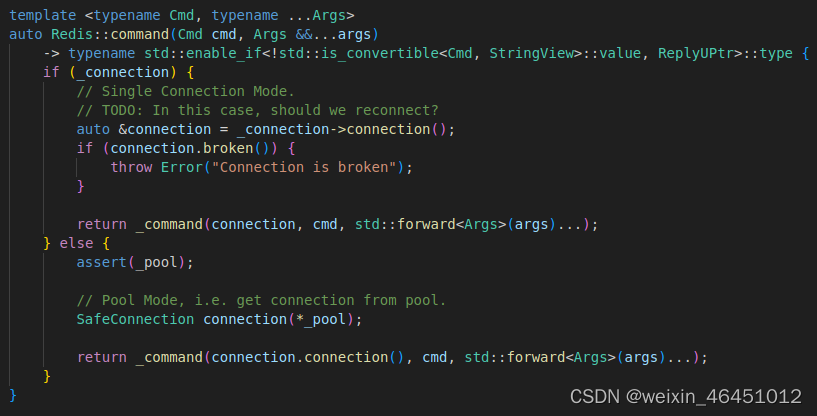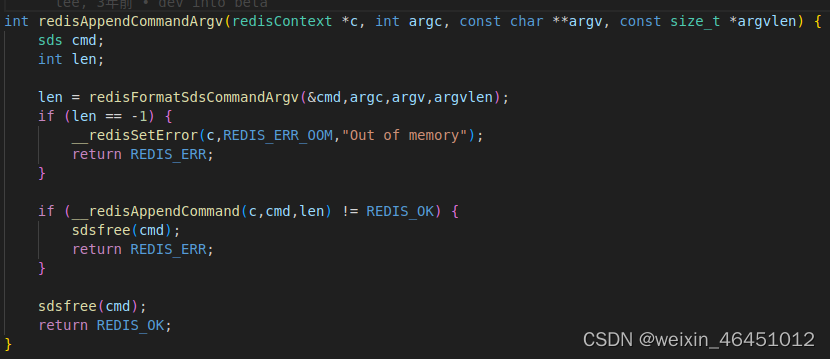redis-plus-plus源码分析
简介
作为c++ 的redis客户端,由于项目中集成redis,选择了使用redis-plus-plus库作为客户端,初次看redis-plus-plus代码,分享下看代码的过程,以便参考。
从官方的readme说起
官方readme已经详细些了安装步骤和使用的demo,安装过程很顺利,没有遇到问题,主要是看demo然后参照源码,去看下怎么连接redis,如何支持redis集群,如果获取数据和设置数据,demo如下:
#include <sw/redis++/redis++.h>
#include <iostream>
using namespace sw::redis;
int main() {
try {
// Create an Redis object, which is movable but NOT copyable.
auto redis = Redis("tcp://127.0.0.1:6379");
// ***** STRING commands *****
redis.set("key", "val");
auto val = redis.get("key"); // val is of type OptionalString. See 'API
// Reference' section for details.
if (val) {
// Dereference val to get the returned value of std::string type.
std::cout << *val << std::endl;
} // else key doesn't exist.
// ***** LIST commands *****
// std::vector<std::string> to Redis LIST.
std::vector<std::string> vec = {"a", "b", "c"};
redis.rpush("list", vec.begin(), vec.end());
// std::initializer_list to Redis LIST.
redis.rpush("list", {"a", "b", "c"});
// Redis LIST to std::vector<std::string>.
vec.clear();
redis.lrange("list", 0, -1, std::back_inserter(vec));
// ***** HASH commands *****
redis.hset("hash", "field", "val");
// Another way to do the same job.
redis.hset("hash", std::make_pair("field", "val"));
// std::unordered_map<std::string, std::string> to Redis HASH.
std::unordered_map<std::string, std::string> m = {{"field1", "val1"},
{"field2", "val2"}};
redis.hmset("hash", m.begin(), m.end());
// Redis HASH to std::unordered_map<std::string, std::string>.
m.clear();
redis.hgetall("hash", std::inserter(m, m.begin()));
// Get value only.
// NOTE: since field might NOT exist, so we need to parse it to
// OptionalString.
std::vector<OptionalString> vals;
redis.hmget("hash", {"field1", "field2"}, std::back_inserter(vals));
// ***** SET commands *****
redis.sadd("set", "m1");
// std::unordered_set<std::string> to Redis SET.
std::unordered_set<std::string> set = {"m2", "m3"};
redis.sadd("set", set.begin(), set.end());
// std::initializer_list to Redis SET.
redis.sadd("set", {"m2", "m3"});
// Redis SET to std::unordered_set<std::string>.
set.clear();
redis.smembers("set", std::inserter(set, set.begin()));
if (redis.sismember("set", "m1")) {
std::cout << "m1 exists" << std::endl;
} // else NOT exist.
// ***** SORTED SET commands *****
redis.zadd("sorted_set", "m1", 1.3);
// std::unordered_map<std::string, double> to Redis SORTED SET.
std::unordered_map<std::string, double> scores = {{"m2", 2.3}, {"m3", 4.5}};
redis.zadd("sorted_set", scores.begin(), scores.end());
// Redis SORTED SET to std::vector<std::pair<std::string, double>>.
// NOTE: The return results of zrangebyscore are ordered, if you save the
// results in to `std::unordered_map<std::string, double>`, you'll lose the
// order.
std::vector<std::pair<std::string, double>> zset_result;
redis.zrangebyscore("sorted_set",
UnboundedInterval<double>{}, // (-inf, +inf)
std::back_inserter(zset_result));
// Only get member names:
// pass an inserter of std::vector<std::string> type as output parameter.
std::vector<std::string> without_score;
redis.zrangebyscore(
"sorted_set",
BoundedInterval<double>(1.5, 3.4, BoundType::CLOSED), // [1.5, 3.4]
std::back_inserter(without_score));
// Get both member names and scores:
// pass an back_inserter of std::vector<std::pair<std::string, double>> as
// output parameter.
std::vector<std::pair<std::string, double>> with_score;
redis.zrangebyscore(
"sorted_set",
BoundedInterval<double>(1.5, 3.4, BoundType::LEFT_OPEN), // (1.5, 3.4]
std::back_inserter(with_score));
// ***** SCRIPTING commands *****
// Script returns a single element.
auto num = redis.eval<long long>("return 1", {}, {});
// Script returns an array of elements.
std::vector<std::string> nums;
redis.eval("return {ARGV[1], ARGV[2]}", {}, {"1", "2"},
std::back_inserter(nums));
// mset with TTL
auto mset_with_ttl_script = R"(
local len = #KEYS
if (len == 0 or len + 1 ~= #ARGV) then return 0 end
local ttl = tonumber(ARGV[len + 1])
if (not ttl or ttl <= 0) then return 0 end
for i = 1, len do redis.call("SET", KEYS[i], ARGV[i], "EX", ttl) end
return 1
)";
// Set multiple key-value pairs with TTL of 60 seconds.
auto keys = {"key1", "key2", "key3"};
std::vector<std::string> args = {"val1", "val2", "val3", "60"};
redis.eval<long long>(mset_with_ttl_script, keys.begin(), keys.end(),
args.begin(), args.end());
// ***** Pipeline *****
// Create a pipeline.
auto pipe = redis.pipeline();
// Send mulitple commands and get all replies.
auto pipe_replies = pipe.set("key", "value")
.get("key")
.rename("key", "new-key")
.rpush("list", {"a", "b", "c"})
.lrange("list", 0, -1)
.exec();
// Parse reply with reply type and index.
auto set_cmd_result = pipe_replies.get<bool>(0);
auto get_cmd_result = pipe_replies.get<OptionalString>(1);
// rename command result
pipe_replies.get<void>(2);
auto rpush_cmd_result = pipe_replies.get<long long>(3);
std::vector<std::string> lrange_cmd_result;
pipe_replies.get(4, back_inserter(lrange_cmd_result));
// ***** Transaction *****
// Create a transaction.
auto tx = redis.transaction();
// Run multiple commands in a transaction, and get all replies.
auto tx_replies =
tx.incr("num0").incr("num1").mget({"num0", "num1"}).exec();
// Parse reply with reply type and index.
auto incr_result0 = tx_replies.get<long long>(0);
auto incr_result1 = tx_replies.get<long long>(1);
std::vector<OptionalString> mget_cmd_result;
tx_replies.get(2, back_inserter(mget_cmd_result));
// ***** Generic Command Interface *****
// There's no *Redis::client_getname* interface.
// But you can use *Redis::command* to get the client name.
val = redis.command<OptionalString>("client", "getname");
if (val) {
std::cout << *val << std::endl;
}
// Same as above.
auto getname_cmd_str = {"client", "getname"};
val = redis.command<OptionalString>(getname_cmd_str.begin(),
getname_cmd_str.end());
// There's no *Redis::sort* interface.
// But you can use *Redis::command* to send sort the list.
std::vector<std::string> sorted_list;
redis.command("sort", "list", "ALPHA", std::back_inserter(sorted_list));
// Another *Redis::command* to do the same work.
auto sort_cmd_str = {"sort", "list", "ALPHA"};
redis.command(sort_cmd_str.begin(), sort_cmd_str.end(),
std::back_inserter(sorted_list));
// ***** Redis Cluster *****
// Create a RedisCluster object, which is movable but NOT copyable.
auto redis_cluster = RedisCluster("tcp://127.0.0.1:7000");
// RedisCluster has similar interfaces as Redis.
redis_cluster.set("key", "value");
val = redis_cluster.get("key");
if (val) {
std::cout << *val << std::endl;
} // else key doesn't exist.
// Keys with hash-tag.
redis_cluster.set("key{tag}1", "val1");
redis_cluster.set("key{tag}2", "val2");
redis_cluster.set("key{tag}3", "val3");
std::vector<OptionalString> hash_tag_res;
redis_cluster.mget({"key{tag}1", "key{tag}2", "key{tag}3"},
std::back_inserter(hash_tag_res));
} catch (const Error &e) {
// Error handling.
}
}
构造Redis连接
Redis对象建立
构造Uri对象
auto redis = Redis(“tcp://127.0.0.1:6379”);
解析 “tcp://127.0.0.1:6379”
默认解析的格式如下
// 指定dbnum
tcp://usr:passwd@ip:port/dbnum
// 没有指定dbnum,含有自定义参数
tcp://usr:passwd@ip:port?parameter_string
首先成三部分, tcp user:passwd ip:port
给 ConnectionOptions 赋值,加进去userid,passwd,host,port,dbnum,type
解析自定义参数
自定义参数的格式 如:
user=xxx&password=xxx&db=xxx
最终给Uri的ConnectionOptions、ConnectionPoolOptions赋值完成构造
使用Uri给ConnectionPool构造,使用ConnectionOptions,ConnectionPoolOptions给ConnectionPool构造函数,生成一个 ConnectionPool智能指针,仅仅是赋值,并不涉及建立连接,Redis对象构造完成。
Redis连接建立
执行
redis.set(“key”, “val”);


可以看到构造Redis时候并没有给_connection赋值,只是初始化,此时先构造一个SafeConnection对象

Connection ConnectionPool::fetch() {
std::unique_lock<std::mutex> lock(_mutex); //锁住连接池
/*
此处先判断,连接池是否是空,如果是空的判断_used_connections是否和连接池容量相等,如果相等则等待直到连接池不为空
如果不相等则新建Connection对象,此时连接没有建立
连接池如果不是空的,从连接池中获取
*/
auto connection = _fetch(lock);
auto connection_lifetime = _pool_opts.connection_lifetime; //获取连接的存活时间
auto connection_idle_time = _pool_opts.connection_idle_time; //获取连接的闲置时间
if (_sentinel) { // 判断哨兵
auto opts = _opts;
auto role_changed = _role_changed(connection.options());
auto sentinel = _sentinel;
lock.unlock();
if (role_changed || _need_reconnect(connection, connection_lifetime, connection_idle_time)) {
try {
connection = _create(sentinel, opts);
} catch (const Error &) {
// Failed to reconnect, return it to the pool, and retry latter.
release(std::move(connection));
throw;
}
}
return connection;
}
lock.unlock();
if (_need_reconnect(connection, connection_lifetime, connection_idle_time)) {
try {
connection.reconnect(); //建立连接使用是hiredis的redisConnect接口
} catch (const Error &) {
// Failed to reconnect, return it to the pool, and retry latter.
release(std::move(connection));
throw;
}
}
return connection;
}
在 SafeConnection中构造函数调用了
_pool的fetch方法拿到了连接,给到了_connection变量
set的执行
CmdArgs 类组装命令 SET KEY VAL

调用了Connection的send方法

完成一次到redis操作
总结
redis++库对hiredis做了封装,使用了懒加载即使用的时候才去建立连接。





















 4459
4459











 被折叠的 条评论
为什么被折叠?
被折叠的 条评论
为什么被折叠?








